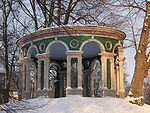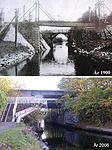Brunnsviken

Brunnsviken (literally The Bay of Wells) is a 3.5 kilometres (2.2 mi) by 0.4–0.5 kilometres (0.25–0.31 mi) brackish lake in Sweden located on the boundary between Solna Municipality and Stockholm Municipality, connecting to Lilla Värtan through Ålkistan. It has a perimeter of 12 kilometres (7.5 mi). Around Brunnsviken there are a wide range of interesting buildings and facilities. Brunnsviken stretches all the way from Vasastaden, Stockholm in the south to Bergshamra, Solna in the north, with Hagaparken along the western shoreline. In the 1700s, Gustav III had plans to build a continuous belt of English parks around the lake. Since 1994, Brunnsviken has been a part of the Royal National City Park.
Excerpt from the Wikipedia article Brunnsviken (License: CC BY-SA 3.0, Authors, Images).Brunnsviken
Tivoli brygga, Solna kommun
Geographical coordinates (GPS) Address Nearby Places Show on map
Geographical coordinates (GPS)
| Latitude | Longitude |
|---|---|
| N 59.37 ° | E 18.038333333333 ° |
Address
HBK
Tivoli brygga
170 74 Solna kommun
Sweden
Open on Google Maps










